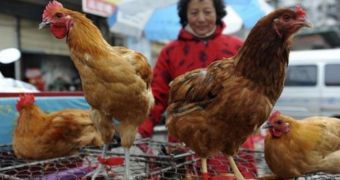About two weeks ago, the news that a novel strain of bird flu had made two victims in China made headlines. Recent information on this topic says that the H7N9 avian flu virus is now spreading across the country.
More precisely, it appears that the virus is moving from China's eastern regions towards the country's central and northern ones.
These claims that the virus is no longer confined to the eastern parts of China are based on the fact that several new human cases have thus far been pinned down in other parts of the country.
Two of these new human cases have been reported in Beijing, whereas other two others have been reported in China's Henan province.
All these four new reports concerning human victims of the H7N9 avian flu virus were issued over the course of this past weekend.
Nature reports us that, since March 31, when the first case of H7N9 caught the attention of both local media and health officials, until this past Monday, a total of 63 infections and 14 deaths linked to this avian flu virus were reported in China.
For the time being, the specialists investigating this novel strain of avian flu virus have no reasons to believe that the virus can spread from one human to another.
Still, several researchers have stressed the fact that the virus is quite prolific in terms of making new human victims.
“This looks very different from H5N1. We never saw this number of presumed avian/animal to human transmissions in such a short space of time,” argued Jeremy Farrar, currently working as the director of the Oxford University Clinical Research Unit in Ho Chi Minh City, Vietnam.
“I think we need to be very, very concerned,” said specialist went on to argue.
What concerns specialists is the fact that neither poultry nor other birds appear to become seriously ill because of this virus. Therefore, tracking and controlling it is bound to be a rather difficult task.
Commenting on the threats that this virus poses to public health both in China and in other parts of the world, epidemiologist Marc Lipsitch stated as follows:
“It's too soon to say how big a threat H7N9 poses because we don't know how many animals of which species have it, how genetically diverse it is, or what the geographic extent is. It looks as though it will be at least as challenging as H5N1.”

 14 DAY TRIAL //
14 DAY TRIAL //